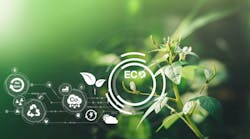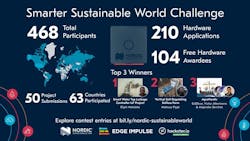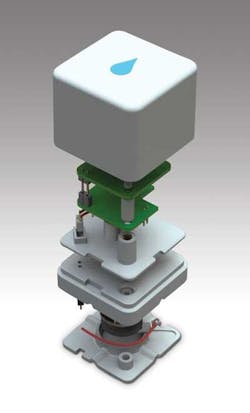This article is part of the TechXchange: The Internet of Things (IoT).
What you’ll learn:
- Corporations are leaning into development of sustainable supply chains.
- Circular economies are founded on the five “Rs”—reduce, reuse, repair, recycle, and restore.
- IoT technology will soon generate enough savings to pay back the energy cost of its manufacture and deployment.
Since the 1980s, the pace of development in the electronics sector has outstripped that of practically any other industry. It has become a leading contributor to the economy of some countries and a major factor in total industrial production in many others.
Moreover, the rate of growth shows no signs of abating. According to analyst Fortune Business Insights, the chip sector alone will expand from $527 billion in 2021 to $1,380 billion in 2029 at a compound annual growth rate (CAGR) of 12.2%.
One downside is that this growth has resulted in large amounts of e-waste—the entrails of dead consumer and industrial electronics. According to the United Nations (U.N.), only 20% of e-waste is successfully recycled today. To encourage better sustainability in the sector, the organization has announced a plan “to substantially reduce waste generation through prevention, reduction, repair, recycling, and reuse” by 2030.
In addition to better handling of e-waste, there’s a growing focus on supply-chain sustainability in electronics and manufacturing with an emphasis on responsible sourcing of materials and reducing the environmental impact of production. But it will be the IoT that provides the platform for a sustainable future.
Corporate Commitment to Sustainability
As befits a global body, the U.N. is helping drive the international sustainability agenda through its Sustainable Development Goals (SDGs). Created in 2015, the 17 SDGs have encouraged organizations to strive to enhance the sustainability of their practices and investments.
While the SDGs are the poster child for sustainable action, regulatory frameworks and commercial dynamics are also encouraging firms to become greener. In addition to enhancing a company’s image, green policies can boost its competitive advantage and strengthen its bottom line.
A 2019 survey by U.S. insurance company Aflac found 77% of consumers are more willing to purchase from companies with an environmental pledge. New NielsenIQ survey data reveals that 46% of consumers look to brands to take the lead on creating sustainable change, while 93% of business leaders believe consumers are likely to hold businesses accountable for their environmental impact, according to the Environmental Defense Fund.
But while an individual company’s action can help toward a sustainable economy, a group of organizations working together can do much more. An industry group called the Responsible Business Alliance (RBA) is committed to sustainable global supply chains. The more than 170 members of the RBA, including Nordic Semiconductor, have now also committed to, and are accountable through, the RBA’s Code of Conduct, driving sustainable value for workers, the environment, and business throughout the global supply chain.
As the importance of environmental sustainability grows, organizations are increasingly being mandated to be part of the transformation toward achieving “net-zero”—or even carbon negative—objectives. And it’s working, said analyst ABI Research. The research firm noted that regulations addressing climate change and environmental impact are influencing greener corporate and product business strategies.
The Power of a Circular Economy
Changing how we do business at the corporate level is going to help, and new business models are helping, too. The old trend to introduce new products every few years has gone away, and, in the process, it’s driven down the volume of e-waste. Sleek new products are designed to last instead of being discarded after just a few years.
One example, reported in The New York Times, is the Fairphone 4, made by an Amsterdam company of the same name. The smartphone has a plastic cover that can be easily removed to expose its internal components. And those components can be replaced in minutes by removing a few ordinary screws.
Other manufacturers are making it easier to fix broken products—meaning trivial faults no longer put expensive devices permanently out of commission—and simplifying disassembly at the end of life to aid recycling. New PCs, TVs, tablets, and wearables are among the consumer products that now offer longer life and easier recycling.
Progressive manufacturers are embracing a circular economy concept. This concept aids sustainability through strategies based on the five “Rs”—reduce, reuse, repair, recycle, and restore—and has the potential to contribute to multiple U.N. SDGs.
By 2025, improved resource productivity could deliver an annual net material cost saving of $600 billion in Europe alone, according to the Ellen MacArthur Foundation, and cut greenhouse gas emissions by 39%.
The Role of the IoT
To reach these ambitious targets, chipmakers and electronic device manufacturers are playing a critical role. Tech products now emphasize reusability, and developers consider recyclability and multipurpose use in their designs from the beginning.
Consumers can expect new devices to be compatible with several generations of previous technology. This forward and backward integration is cutting down on e-waste and discouraging over-consumption. Meanwhile, tech advances such as over-the-air firmware updates increase end-product longevity, ensuring users don’t have to buy new hardware to access the latest software features.
While consumers and corporations are changing their habits, protecting the planet and its resources for tomorrow will also need widespread deployment of new technology. The U.N. has already recognized the transformative power of tech in its 2030 Agenda for Sustainable Development.
The IoT will form a foundation platform for sustainable tech. But first it needs to be fully rolled out and that will incur an energy cost. Will that cost be worth it? A Transforma Insights and 6GWorld report, “Sustainability in New and Emerging Technologies In 2030,” highlights that IoT technology will soon generate enough savings to pay back the energy cost of its manufacture and deployment and, from then on, will save around 8X the energy it consumes.
The benefits of big data are also expected to be crucial in justifying the IoT’s environmental footprint. When combined effectively with, for example, machine-learning applications, the IoT will generate swathes of information to help people and organizations better understand their energy costs and make informed environmental decisions.
Moreover, the key green benefits of the IoT will largely come from enterprise solutions, which are generally associated with efficiency savings. This often takes place in the form of reduced electricity consumption, leading to lower carbon emissions or reduced fuel or water consumption, for example, through smart electricity grid operations.
Current Solutions Reducing Waste
On more modest scales, innovative developers are doing their bit to use the IoT to create solutions that cut down the amount of resources consumed by the world. For example, the Smarter Sustainable World Challenge with Nordic Semiconductor competition—launched with hardware education community hackster.io (an Avnet company)—called on participants to plan, design, and prototype cutting-edge solutions that reduce humanity’s ecological footprint using the power of sensors and wireless connectivity (Fig. 1).
The overall winner, South Africa’s Elijah Maluleke, created a smart water-tap leakage controller that automatically closes a valve whenever there’s an abnormal flow of water through the water tap. The volume of water saved by using the IoT device, when scaled to millions of water sources, would have a huge impact on conservation efforts.
Nordic Semiconductor customers are also sustainably developing innovative solutions to help other businesses and communities work toward a greener future. One example is China-based MOKO Smart’s MK117NB Smart Plug, a Nordic Semiconductor-powered Bluetooth LE/cellular IoT electricity plug that can be used to monitor energy usage and save power consumption by remotely controlling load switches (Fig. 2).
Another is Canadian technology firm AquaSensing’s Leak Sensor 1.0, a battery-free, self-powered leak-detection device that uses a sensor as both its power source and for detecting water leaks (Fig. 3). The solution harvests energy from any fluid ingress to power a Nordic Semiconductor chip. This chip then connects wirelessly to a smartphone, from where the user can receive alerts of active leaks via an accompanying app.
Reducing Reliance on Batteries
Network equipment provider Cisco suggests that in as little as a decade, there could be more than 50 billion wireless and cellular IoT sensors. Many of those will be powered by batteries, which threatens to undermine the IoT’s sustainability credentials. Exotic materials such as lithium must be mined, the cells must be fabricated, and then they’re distributed around the world. There’s also the major problem of safely disposing of them once exhausted.
In response to this challenge, chipmakers like Nordic Semiconductor are designing next-gen wireless solutions to be even more efficient, extending the range of applications that will be able to harvest all of their energy from the environment. And a new generation of power-management ICs (PMICs), customized for energy-harvesting devices, will stabilize the variability of harvested-energy sources and play a significant part in freeing IoT products from batteries.
Together with clever engineers, progressive politicians, and savvy consumers, the IoT can ensure sustainability becomes a part of everything we design, manufacture, use, and discard—and help protect the planet for future generations.
Read more articles in the TechXchange: The Internet of Things (IoT).



